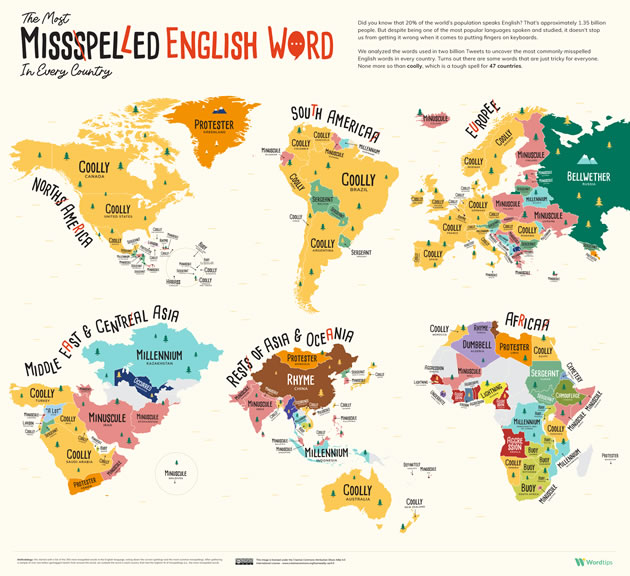Recently I was asked to share a post about The Most Misspelled English Word in Every Country and State, Based on Two Billion Tweets.

However, on a list of the 100 Most Commonly Misspelled Words on YourDictionary.com, foreign and miniscule do appear, but coolly and promise don’t.
Miniscule is in fact a “disputed spelling variant of minuscule”, according to the Merriam-Webster dictionary. It as been around since the late 19th century and often appears in print, although is “widely regarded as an error”.
This got me thinking – if a word is widely misspelled / misspelt*, is this a sign of language change? Maybe one day the misspelling will be accepted as an alternative way to spell the word, or even as the standard way to spell it.
*misspelt is used in the UK, though has become less widely-used since the 1970s, while misspelled is used in most English-speaking countries, including the UK [source].
English spelling is not entirely fixed, and some words may have more than one standard spelling, particularly in different varieties of English.
According to Wikipedia, “Spelling is a set of conventions that regulate the way of using graphemes (writing system) to represent a language in its written form … Spelling is one of the elements of orthography, and highly standardized spelling is a prescriptive element.”
Standardized / standardised spelling is a relatively recent phenomenon that developed along with dictionaries, universal education, literacy and language academies. It is enforced by teachers, proofreaders, editors and pedants.
In the past, spelling was very much a matter of personal choice. For example, there are six known signatures written by William Shakespeare, each of which is spelled differently: Willm Shakp, William Shaksper, Wm Shakspe, William Shakspere, Willm Shakspere and William Shakspeare [source]. In printed works his name appears as Shake‑speare, Shakeſpeare, Shak‑speare and Shakeſpere. The Shakespeare spelling became popular from the 1860s [source].
Does spelling matter?
It does, at least in formal writing. In informal writing, it may not be so important, as long as your message is clear. In fact, non-standard spellings might be preferred in some contexts. They are certainly a popular way to make brandnames distinct – Kwik Fit, Krispy Kreme, etc.
I suspect that deliberate misspelling in brand names is not so much used to make them “distinct” as to allow them to be copyrighted. You can’t copywrite a common word like “five” but it’s possible you could copyright a (crazy) made-up word like ” f ī v v é “.
FYI, I’m not suggesting that anyone DOES.
Id sai dhat wuz juzd dum.
Until a few years ago the word I most often misspelt was “misspelt”. I knew what it logically ought to be, but I still had a tendency to write “mispelt” .
Just curious, Simon, I see this new G logo thing you are displaying. A merging of O and G for Omniglot? Of course, as you know, I have tried spelling it as OmniGlot for a long time, so now I’ll want to do so twice as much :-))
Now all you need to do is petition the Unicode Consortium for a new glyph. We could call it:
LATIN CAPITAL LETTER COUNTERCLOCKWISE HALF-TURNED G
Has a nice ring to it, wouldn’t you say?
Cheers
Robert – not sure which logo you mean. Could you send me a screenshot?
I live in Canada and get SO tired of having Autocorrect underline any British spellings like neighbour and centre. My ex-wife went to a US university for her Masters degree and was marked down for any British spellings even though she explained to the prof that it was perfectly OK in Canada. He declined to change the grade.
Hank, if it’s your own word processor like MS Word, you should be able to change the Language settings to English-Canadian.
FWIW, I think the professor’s actions were needlessly discriminatory. It’s not an “error” to use the language, grammar and orthography of your native land. It’s normal. You shouldn’t be marked down for being normal.
Robert – that logo is generated automatically. If you want to change it, you can make your own at: https://en.gravatar.com/
No, on the contrary, I think you should make the official logo of Omniglot. I like it. It looks like a merging of O and G, ala OmniGlot. Your current logo is very clever, I will give you that, but as you know, I always thought it was two mosquitos talking to each other. I never saw “Omni + Glot” in it, until you pointed it out one day.
Like Robert, I never realized that the shapes in the centre of the logo spelled ‘Omni – glot’ – I presumed it was some vertically-written script, perhaps of Asian origin.
I’m puzzled by Robert’s reference to the ‘merged O + G’ logo, although clearly Simon knows. Where is it to be seen, please?
Shenn, I see it on the your very own post, above. Can’t you see it? It’s white with a blue background, and looks like a capital G turned 90 degrees counter-clockwise.
Robert, thank you for teaching the blind to see! I still think it looks more like an ‘on/off’ switch on a computer screen!
It’s very similar to the ON/OFF symbol, but that is more like an O with a vertical line on the top half. It’s close, but not quite the same.
Shenn Ghaelgeyr – you can find details of the Omniglot logo at: https://www.omniglot.com/logo.htm
I suspect the Gravatar logo is copyrighted.